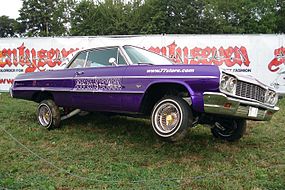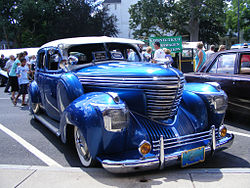A lowrider (sometimes low rider) is an automobile or other vehicle modified so that its ground clearance is less than its design specification. This can be accomplished by installation of tires with an outer diameter smaller than normally specified for the vehicle, or by more extensive modifications. Such modifications are done to appeal to certain cultural aesthetics, or to alter the vehicle's performance by changing the vehicle's aerodynamic properties, to reduce its center of gravity, or to change the effective gear ratiosof the drivetrain.
The term "lowrider" can refer to both the vehicle and its owner or operator; the verb form "lowriding" can likewise refer to the process of modifying a vehicle in this manner, or to its operation.
The opposite of a lowrider is a Hi-Riser.

References[edit]
- Brown, J (2002). "DIPN The Industry of Low Riding", Dream Factory Films, 1(2)(3).
A lowrider is a customized car originated by Mexican Americans in Southern California. Many lowriders have hydraulic suspension systems (modified suspension) so that their ride can change height at the flip of a switch. Lowriders are commonly classic cars from the 1950s (when lowriding began). However, large numbers of 1940s to 2000s model cars are also modified; to an uncommon degree newer vehicles are also modified. The word is also used to refer to those who drive or own such cars. A lowrider will traditionally have many factory-offered accessories or options and often many after-market accessories added.
Description of the subculture[edit]
The concept of low-riding first emerged during the post-war prosperity of the '50s. Initially, some youths would place sandbags in the trunk of their customized cars in order to create a lowered effect.[citation needed] This method was replaced by lowering blocks, cut spring coils, z’ed frames and drop spindles. The aim of the lowriders is to cruise as slowly as possible, "Low and Slow" being their motto. By redesigning these cars in ways that go against their intended purposes and in painting their cars so that they reflect and hold meanings from Latin culture, lowriders create cultural and political statements that go against the more prevalent Anglo culture.[1] The design of the cars encouraged a "bi-focal perspective-they are made to be watched but only after adjustments have been made to provide ironic and playful commentary on prevailing standard of automobile design." [2]However, this resulted in a backlash: the enactment of Section 24008 of the California Vehicle Code in January 1, 1958, which made it illegal to operate any car modified so that any part was lower than the bottoms of its wheel rims.
In 1959, a customizer named Ron Aguirre developed a way of bypassing the law with the use of hydraulic Pesco pumps and valves (scavenged from a surplus B-52 bomber) that allowed him to change ride height at the flick of a switch. 1958 saw the emergence of the Chevy Impala which featured an X-shaped frame that was perfectly suited for lowering and modification with hydraulics. Between 1960 and 1975, customizers adapted and refined GM X-frames, hydraulics, and airbrushing techniques to create the modern lowrider style. The oldest car cruising strip is Route 44. In the lowrider world Whitter Blvd. and Crenshaw are historical.[citation needed]
Today, the lowriding scene is diverse with many different cultures, vehicle makes and visual styles, however, it remains an important part of Chicano history. Essentially all the options available to today's custom automobile creator are also available to the lowrider builder, and lowrider style varies greatly from region to region.[3]
Summer is the most popular season for lowriders, as the weather often encourages being outside either in or nearby the vehicle. Some lowrider clubs have weekly gatherings in the summer where owners of lowriders and friends will have a barbecue followed by cruising a popular drag (or strip) after dark. Aside from local drags and their parking lots, lowriders are most commonly seen at privately organized lowrider car shows that often feature a variety of different vehicular and non-vehicular events, the most popular of which are the wet T-shirt/bikini contests and the hop and dance hydraulic competitions where competitors compete against each other to see who can hop the highest or complete a list of moves within a time limit (dancing). There are several magazines devoted to presenting, preserving, and chronicling lowrider culture, the best known of which is Lowrider Magazine, currently published by Primedia.
Description of vehicles[edit]
The 1964 Chevy Impala hardtop or convertible is one of the most popular lowriders, and to a lesser extent other 1958-1966 Impalas.[4] Although the 1961–66 Chevrolet Impala is usually sought after by car collectors, vehicles including the 1978–88 GMG-bodies (which includes the Chevrolet Monte Carlo, Buick Regal, Oldsmobile Cutlass Supreme, and Pontiac Grand Prix) and their 1973–77 relatives are usually seen as entry-level lowriders. Although heavy customization of the cars is popular in the lowrider scene, some lowriders pass for restored stock cars, especially those based on 1930s–1960s American cars. In some countries, other cars like the Standard Vanguard, Volvo PV544, Morris Minor, air-cooled VW Beetle, Ford Zodiac, Vauxhall Victorand Vauxhall Cresta (and other cars with American styling) are often used as substitutes for American cars.
Exterior[edit]
Lowrider exteriors range from conservative enough to pass for a restored stocker to outright campy. The more conservative often feature period accessories such as sun visors, fender skirts, bug deflectors, exhaust deflectors, curb feelers (often electric), vent window "breezies" or deflectors, and swamp coolers, along with factory options available at the time. Interiors will often appear as if they came from the factory, with sound systems concealed.
The more outrageous exteriors typically feature expensive custom paint jobs that consist of several thin layers of different colors, metal oxide flake or pearl flake, clear coat, metal leaf, airbrushed murals or script, pinstripes, flames or any other hand-painted graphics, or any combination of the above. Lowriders traditionally feature small gold or chrome spoke wheels (which can tuck into the wheel well for the lowest ride height, but can look out of proportion when the car is raised to stock ride height), with or withoutknockoffs and whitewall tires (although steels and period or factory hubcaps were also common on cars built before 1960). Other traditional Lowrider wheels are Astro Supremes, Cragers, Tru spokes, Crowns, Daytons and Zeniths, all with 5.20 tires which were used during the 1970s and early 1980s. Other common custom exterior enhancements are rear wheel skirts, extensive use of chrome or gold, antennas or fins and Continental tire kits (a full matching spare tire on display in a rear bumper case). The most detailed vehicles have engine, exhaust and performance modifications and/or beautifications.
Other common modifications are unusual doors, such as suicide doors (doors hinged at the rear), scissor doors (doors opening vertically) and gull-wing doors (doors hinged at the roof) more common in hi-risers.
Hydraulics[edit]
Many Lowriders feature custom hydraulic suspensions that allow the driver to alter the ride height at will. At first, aircraft pumps, valves, and hoses were used. Later it was found that the liftgate trucks had more compact units and these units were soon replacing the aircraft units. These systems range from simple to complex and are usually measured by the number of hydraulic pumps (generally 2 to 4) used to control the various hydraulic combinations that ultimately produce a specific motion from the vehicle. These pumps are powered by multiple batteries installed in a rack in the trunk of the vehicle. The speed at which the car lifts depends partly on the voltage generated by these batteries, which can range from 12 VDC all the way up to 120 VDC. The most common motions are dipping/raising the four corners of the vehicle (Diamond lifts), dipping/raising the front or rear of the vehicle (front, back), dipping/raising the sides of the vehicles (side to side, which started around 1978), and lowering/raising the vehicle as a whole (pancake). A skilled switch operator can manipulate their controls to raise one wheel completely off the ground (3-wheel motion), or to hop one end of the car completely off the ground.
Around the mid-1970s, it was found that adding more batteries could get the front wheels to actually hop off the ground. This created a whole new sport with respect to hydraulics in Lowriders. Cars at that time could lift the front wheels off the ground about the height of a 12 ounce can.[clarification needed]
Interior[edit]
Most people customize their interiors, either by restoring it to original condition, or modifying it to match the exterior of the vehicle. This can be rather expensive once cost of materials and labor are accounted for. Some people install video monitors either on the inside of the doors, the back of the seats, or the center console. Additional graphics may accent a customized interior. Steering wheels are often replaced to match other modifications better.
Paint, neon or LED lights, chrome or gold accents, cosmetic mirrors, aftermarket steering wheels (of which a chain-link steering wheel is iconic), fuzzy dice that hang from the rear-view mirror or head rests and swivel seats that allow for easier and more stylish entry and exit. Traditionally, lowriders used velvet, mirrors, smoothed out panels, and woodgrain however that is often considered old school as more modern techniques and materials have come into popularity.
Many low riders now feature any combination of mobile electronic audio and video devices, most stereotypically a loud audio system that features a powerful amp and largesubwoofers (commonly referred to as "subs" and "woofers") and primarily focuses on producing heavily-exaggerated bass. Miniature TV screens embedded into the headrests of the seats are popular, and accompanying devices include DVD players and, more recently, video game consoles outfitted with wireless controllers.


No comments:
Post a Comment